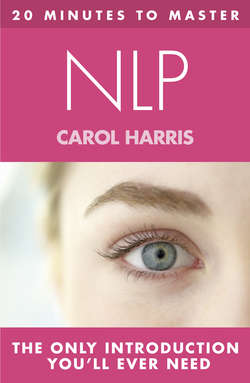Читать книгу 20 MINUTES TO MASTER ... NLP - Carol Harris - Страница 21
THOUGHTS
ОглавлениеThe elements of thought involve seeing (visualizing), hearing (imagining sounds or having ‘internal conversations’ or dialogue in one’s head), experiencing sensations (emotional or tactile), sensing smells or sensing tastes. In each of these areas, NLP enables people to notice their thoughts and then, if needed, to modify them and thereby their experience.
For example, you might ask someone to think about a flower. First they can imagine how the flower looks (its colour and shape), then imagine how it smells (its scent), then imagine how it feels (its form and texture), then imagine how it sounds (perhaps its leaves rustling in a breeze), then imagine how it tastes (some flowers are edible!) So far, the experience has been imitating reality – you have asked the person to imagine a real flower, as it is usually perceived. Now for the interesting part: you can ask the person to manipulate their mental experience to create something entirely new. So, for example, you might ask the person to imagine the flower a different colour, a different size, with a different smell, making an unusual sound, and so forth. The ability of the mind to make these changes is a foundation for learning and innovation, and if you have never experimented in such a manner, you may be amazed at the changes in experience which such shifts can bring about.
Because of its ability to manipulate the senses, NLP can help people create more (or less) pleasant experiences for themselves. And in case you are wondering why they should want to create a less pleasant experience, think of how to teach someone to avoid putting their hand in a hot fire, or how to make sure they don’t drive after they have been drinking.
